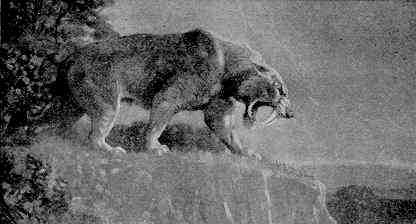
Coleodonta, the Woolly Rhinoceros of the last ice-age, was a contemporary of early man
illustration by Charles R. Knight - from Early Image - public domain images
| Pleistocene Epoch | ||
| Cenozoic: Neogene Period |
Pleistocene |
| Neogene | Time | Holocene | ||
| Cenozoic | Paleogene | Pliocene | History |
 Coleodonta, the Woolly Rhinoceros of the last ice-age, was a contemporary of early man illustration by Charles R. Knight - from Early Image - public domain images |
The Pleistocene Epoch covers a little over one and a half million years. This epoch witnessed a continued cooling, culminating in a series of ice ages. The great mammalian megafauna are flourishing, and the hominid primates have become increasingly skilled at the use of fire and tool-making.
The term Pleistocene ("most recent") was coined by Charles Lyell in 1839, on the basis of a section of type strata in eastern Sicily, according to the proportion of extinct to living species of mollusk shells in the sediment. Strata with 90 to 100% present day species were designated Pleistocene. Clearly this is a somewhat arbitrary arrangement, and in any cases many strata do not contain mollusk shells.
The present definition of the Pleistocene is based on radiometric dating of 1.8 million years or more recent, the presence of cooler water mollusks and foraminifers, the absence of marine micro-organisms called discoasters, and on land the fossil remains of modern horses and true elephants (in the past more widespread than they are today).
About a third of the way into the Pleistocene the first Ice Age hit. There were a series of advances and retreats of the ice as the climate fluctuated between cold (glacial) and warm (interglacial) periods. The sea level rose during the melting of the glaciers, then dropped again during the next long cold spell (ice formation). The lowered sea levels formed land bridges that enabled the migration of animals and humans across continents.
 Smilodon, the great saber-tooth cat, lived in North America and was as large as a lion illustration by Charles R. Knight - from Early Image - public domain images |
The Pleistocene saw the age of mammals is at its height, with both small and giant forms living alongside each other. Animals and plants are basically modern species, although distributions were unusual; e.g. hippos and elephants in what is now London during the warm interglacial periods. There were however many giant mammals - the so called megafauna - which evolved and lived on all the worlds continents. In Australia for example there were giant kangaroos and wombats (as well as a number of forms with no living relatives), in Europe the mammoth and woolly rhinos, in America the mastodon, camels, and dire wolves, in South America elephant-sized ground sloths and giant armadillo-like creatures called glyptodonts.
During the Pleistocene the hominid tendency to increase brain size and hence intelligence continued. Homo erectus, Homo neanderthalis, and finally modern man (Homo sapiens) succeeded each other in time (although modern man and neanderthals lived alongside each other in Europe for a short period, an event popularized in fiction by writers like William Golding (The Inheritors) and Jean Aeul (Clan of the Cave Bear). Interestingly, neanderthal man had a larger brain capacity than modern man, but still died out. As one of my university tutors once quipped when this was mentioned, a race of philosophers?
| Pleistocene Epoch | Late Pleistocene |
| Middle Pleistocene | |
| Early Pleistocene |
University of California Museum of Paleontology -- The Pleistocene
Land of the Mammoth - Discovery Channel
Evolving Toward Humans - annotated links page from Richard Cowen's History of Life site - mirror at Howcomyoucom
The Pleistocene Ice Age - annotated links page from Richard Cowen's History of Life site - mirror at Howcomyoucom
Humans and the Ice Age - - annotated links page from Richard Cowen's History of Life site - mirror at Howcomyoucom
The following is highly recommended:
Quaternary Extinctions : A Prehistoric Revolution by Paul S. Martin and Richard G. Klein (Editors) - essays by different writers on the mystery of the Pleistocene extinctions.
| Pliocene |
Page MAK980528 last modified MAK111015,
checked ATW030930